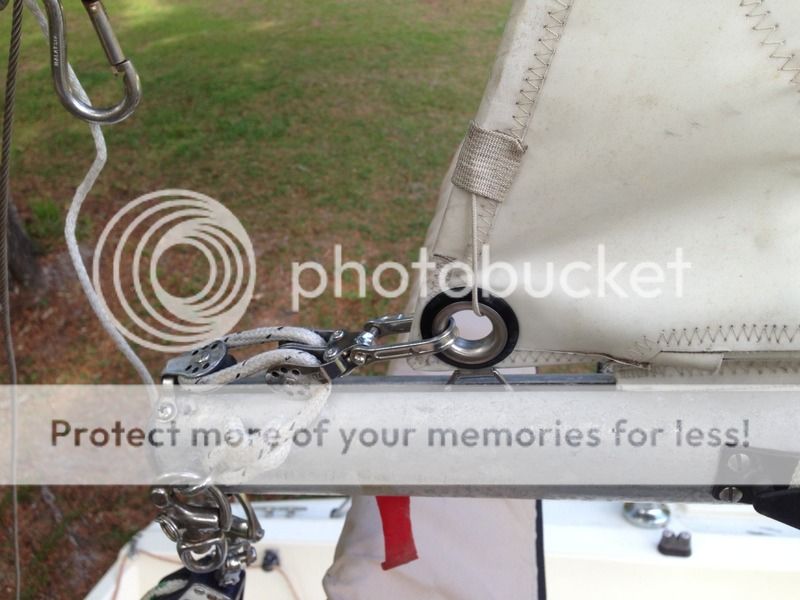Hawk ...
First off your mainsail only has a 'flattening reef', not a 'full' 1st reef. Such a flattening reef will only reduce the sail area down to the level of 'top' of the curvature (belly) of the area of the shelf foot. A typical 'full' first reef will usually be in the range of 15-20% reduction of sail area. To add a full first reef on your 'crosscut' main, that #4 batten (which seems lower than 'normal') will have to be resewn to be parallel with the boom, not aligned with the sail panel seams as that would cause potential breaking of the batten or would prevent a tight roll-up of the loose area below the level of the first reef (when you tie in the 'bunts') ..... not a 'big deal', and would make reefing much easier.
As regards sail shape (bagginess, etc.), in both pics, it simply appears that the sail is not correctly tensioned along the luff and along the foot. The pic with you sailing the boat shows that you dont have proper luff tension (the aft end of the boom seems much lower than the tack ... not enough luff tension). Go to http://forums.sbo.sailboatowners.com/showthread.php?t=120970 and read post #1 to get the proper luff tension and then use the same description for proper foot tension (1" extra stretch per 10 ft. of foot length) 'after' a no-load stretch out. This will allow you to make a decision if those 'bolt ropes' need to be eased and reset by a sailmaker to proper length. Proper edge tension will give better/proper as-designed sail shape, especially for sailing in the higher wind ranges. Improperly raised dacron sails are ALWAYS 'baggy'.
When making your decision based on that above link ... go sailing on a beat & use only 'moderate' mainsheet tension ...... and then look at the condition of the leech area especially between battens #1 & #2 as that area of the roach will have the most designed-in 'curvature' ... and if the sail is stretched out beyond useful life - it will most likely show up there as a 'fluttering' of the leech only or mostly between battens #1 #2 when the leech line (if you have one) is tensioned and the leech is not 'cupped up' by an inch or two (too tight leech line). A leech correction to 're-taper' to correct the permanently stretched out fabric would be costly and even if performed may not bring the shape back to 'suitable'. If the leech is not fluttering between these two battens, then most probably this sail has LOTS of useful life left in it ... if the fabric and stitching is not severely UV 'burned'.
From the pics it appears that the sail material and its stitching seem fine. The chief reason to replace the sail would be indications of UV 'burn' of the material and lots of broken stitching also due to UV burn of the thread - that would indicate a 'weakened' sail caused by too much sun exposure. Take the sail to a sail loft for evaluation and to discuss adding in a proper first reef, including a repositioning of batten #4 to be parallel with the boom. Do the on-the-water evaluation as described in that offered post, first -- to see if or not you can 'stretch out' that sail to its original 'as-designed' shape, first! The reason being if the leech needs to be tightened, the luff and foot boltropes need to be eased/reset, ... all that plus the addition of a standard reef 'may' be more expensive than simply buying a 'plain vanilla' new sail.
As other have stated, boats of this size usually dont reef, they usually flatten (.... by tying-in that 'flattening reef' to reduce the amount of draft in the lower panels caused by that 'shelf foot'). If you want a deeper reef added ... go for it!!!! But if and only if the sail still has 'decent shape' and the fabric is not weakened by abuse and sunlight. ;-)
Do the evaluation as described in 'How to properly raise a Dacron Mainsail", and use the same directions to also properly stretch out that foot as well as that luff boltrope .... first. Use MORE 'stretch out' for sailing in winds higher than 12-15kts (and also for sailing in 'very light' winds too).
hope this helps.
First off your mainsail only has a 'flattening reef', not a 'full' 1st reef. Such a flattening reef will only reduce the sail area down to the level of 'top' of the curvature (belly) of the area of the shelf foot. A typical 'full' first reef will usually be in the range of 15-20% reduction of sail area. To add a full first reef on your 'crosscut' main, that #4 batten (which seems lower than 'normal') will have to be resewn to be parallel with the boom, not aligned with the sail panel seams as that would cause potential breaking of the batten or would prevent a tight roll-up of the loose area below the level of the first reef (when you tie in the 'bunts') ..... not a 'big deal', and would make reefing much easier.
As regards sail shape (bagginess, etc.), in both pics, it simply appears that the sail is not correctly tensioned along the luff and along the foot. The pic with you sailing the boat shows that you dont have proper luff tension (the aft end of the boom seems much lower than the tack ... not enough luff tension). Go to http://forums.sbo.sailboatowners.com/showthread.php?t=120970 and read post #1 to get the proper luff tension and then use the same description for proper foot tension (1" extra stretch per 10 ft. of foot length) 'after' a no-load stretch out. This will allow you to make a decision if those 'bolt ropes' need to be eased and reset by a sailmaker to proper length. Proper edge tension will give better/proper as-designed sail shape, especially for sailing in the higher wind ranges. Improperly raised dacron sails are ALWAYS 'baggy'.
When making your decision based on that above link ... go sailing on a beat & use only 'moderate' mainsheet tension ...... and then look at the condition of the leech area especially between battens #1 & #2 as that area of the roach will have the most designed-in 'curvature' ... and if the sail is stretched out beyond useful life - it will most likely show up there as a 'fluttering' of the leech only or mostly between battens #1 #2 when the leech line (if you have one) is tensioned and the leech is not 'cupped up' by an inch or two (too tight leech line). A leech correction to 're-taper' to correct the permanently stretched out fabric would be costly and even if performed may not bring the shape back to 'suitable'. If the leech is not fluttering between these two battens, then most probably this sail has LOTS of useful life left in it ... if the fabric and stitching is not severely UV 'burned'.
From the pics it appears that the sail material and its stitching seem fine. The chief reason to replace the sail would be indications of UV 'burn' of the material and lots of broken stitching also due to UV burn of the thread - that would indicate a 'weakened' sail caused by too much sun exposure. Take the sail to a sail loft for evaluation and to discuss adding in a proper first reef, including a repositioning of batten #4 to be parallel with the boom. Do the on-the-water evaluation as described in that offered post, first -- to see if or not you can 'stretch out' that sail to its original 'as-designed' shape, first! The reason being if the leech needs to be tightened, the luff and foot boltropes need to be eased/reset, ... all that plus the addition of a standard reef 'may' be more expensive than simply buying a 'plain vanilla' new sail.
As other have stated, boats of this size usually dont reef, they usually flatten (.... by tying-in that 'flattening reef' to reduce the amount of draft in the lower panels caused by that 'shelf foot'). If you want a deeper reef added ... go for it!!!! But if and only if the sail still has 'decent shape' and the fabric is not weakened by abuse and sunlight. ;-)
Do the evaluation as described in 'How to properly raise a Dacron Mainsail", and use the same directions to also properly stretch out that foot as well as that luff boltrope .... first. Use MORE 'stretch out' for sailing in winds higher than 12-15kts (and also for sailing in 'very light' winds too).
hope this helps.
Last edited:






